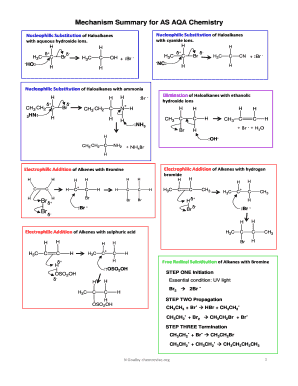
Mechanism Summary Aqa Chemistry Form


What is the Mechanism Summary Aqa Chemistry
The Mechanism Summary AQA Chemistry is a comprehensive outline that details the various chemical mechanisms involved in reactions. This summary serves as a crucial resource for students and professionals, providing insights into the step-by-step processes that govern chemical interactions. It includes information on reaction types, intermediates, and transition states, enabling users to understand the underlying principles of chemistry more effectively.
How to Use the Mechanism Summary Aqa Chemistry
Utilizing the Mechanism Summary AQA Chemistry involves familiarizing oneself with the outlined mechanisms and applying them to relevant chemical problems. Users can reference the summary to identify specific reaction pathways and mechanisms, which can enhance their understanding of complex chemical processes. It is beneficial for exam preparation, research, and practical applications in laboratory settings.
Steps to Complete the Mechanism Summary Aqa Chemistry
Completing the Mechanism Summary AQA Chemistry requires several key steps:
- Review the fundamental principles of chemistry to ensure a solid foundation.
- Study each mechanism in detail, focusing on the sequence of reactions and the role of intermediates.
- Practice applying the mechanisms to various chemical equations and scenarios.
- Utilize diagrams and flowcharts to visualize the steps involved in each mechanism.
Legal Use of the Mechanism Summary Aqa Chemistry
The Mechanism Summary AQA Chemistry is legally usable as an educational tool, provided it is used in compliance with copyright regulations. Users should ensure that they reference the summary appropriately and do not reproduce it in a manner that violates intellectual property rights. Educational institutions and students can freely use this summary for study and instructional purposes.
Key Elements of the Mechanism Summary Aqa Chemistry
Key elements of the Mechanism Summary AQA Chemistry include:
- Detailed descriptions of each chemical mechanism.
- Visual aids, such as diagrams illustrating reaction pathways.
- Examples of common reactions associated with each mechanism.
- Important terminology and definitions relevant to the mechanisms.
Examples of Using the Mechanism Summary Aqa Chemistry
Examples of using the Mechanism Summary AQA Chemistry can be found in various academic and practical contexts. For instance, students may apply the summary to solve reaction mechanism problems in examinations. Additionally, researchers can reference it when designing experiments that involve specific chemical reactions, ensuring accurate and efficient methodology.
Quick guide on how to complete as chemistry mechanisms
Easily Prepare as chemistry mechanisms on Any Device
Online document management has gained signNow popularity among companies and individuals. It offers a perfect environmentally friendly option compared to conventional printed and signed documents, allowing you to obtain the necessary form and securely store it online. airSlate SignNow provides you with all the resources required to create, edit, and eSign your documents swiftly and without delays. Manage as chemistry mechanisms on any platform using the airSlate SignNow Android or iOS applications and enhance any document-based procedure today.
The Simplest Way to Edit and eSign mechanisms aqa a level chemistry Effortlessly
- Locate a level chemistry mechanisms and click Get Form to begin.
- Utilize the tools we offer to finalize your form.
- Emphasize important sections of your documents or redact sensitive information with tools that airSlate SignNow specifically provides for that purpose.
- Create your eSignature using the Sign tool, which takes mere seconds and holds the same legal validity as a traditional wet ink signature.
- Verify the information and click the Done button to save your modifications.
- Select your preferred method to share your form, via email, SMS, or invitation link, or download it to your computer.
Eliminate the worries of lost or misplaced files, tedious form searching, or mistakes that necessitate printing new document copies. airSlate SignNow fulfills your document management needs in just a few clicks from your chosen device. Edit and eSign mechanism summary aqa chemistry to ensure outstanding communication throughout your document preparation process with airSlate SignNow.
Create this form in 5 minutes or less
Related searches to as chemistry mechanisms
Create this form in 5 minutes!
How to create an eSignature for the mechanisms aqa a level chemistry
How to create an electronic signature for a PDF online
How to create an electronic signature for a PDF in Google Chrome
How to create an e-signature for signing PDFs in Gmail
How to create an e-signature right from your smartphone
How to create an e-signature for a PDF on iOS
How to create an e-signature for a PDF on Android
People also ask mechanism summary aqa chemistry
-
What are the essential features of airSlate SignNow related to as chemistry mechanisms?
airSlate SignNow offers several features that streamline document signing processes, essential for understanding as chemistry mechanisms. Users can create templates, automate workflows, and track the status of documents, making it easier to understand and analyze chemical reactions and interactions.
-
How can airSlate SignNow benefit my business in the context of as chemistry mechanisms?
By utilizing airSlate SignNow, businesses can enhance their efficiency in managing documents related to as chemistry mechanisms. The platform allows for quick signatures and secure sharing, which accelerates collaboration among teams and partners in the field of chemistry.
-
What is the pricing structure for airSlate SignNow when considering as chemistry mechanisms?
airSlate SignNow offers flexible pricing plans to accommodate different business sizes and needs. These plans provide access to features that support document management and signing processes relevant to as chemistry mechanisms, ensuring affordability without compromising quality.
-
Does airSlate SignNow integrate with other tools used for as chemistry mechanisms?
Yes, airSlate SignNow integrates seamlessly with various tools that are commonly used in the field of as chemistry mechanisms. This includes popular platforms like Google Drive and Slack, enhancing collaboration and ensuring that documents can be securely accessed and signed within your existing workflows.
-
How secure is airSlate SignNow for managing documents related to as chemistry mechanisms?
Security is a top priority for airSlate SignNow, especially when handling documents pertinent to as chemistry mechanisms. The platform employs robust encryption methods and complies with industry standards, ensuring that sensitive information remains protected throughout the signing process.
-
Can I customize document templates for as chemistry mechanisms in airSlate SignNow?
Absolutely! airSlate SignNow allows users to create and customize document templates specifically tailored for as chemistry mechanisms. This feature enables you to standardize documents, making it easier to fill out and sign multiple times as you handle various chemistry-related tasks.
-
Is there support available for users of airSlate SignNow in relation to as chemistry mechanisms?
Yes, airSlate SignNow provides comprehensive support resources for users, particularly beneficial for those focusing on as chemistry mechanisms. You can access tutorials, a knowledge base, and customer support to help solve any issues or optimize your document signing experience.
Get more for as chemistry mechanisms
- Employee cell phone agreement template form
- Employee commission agreement template form
- Employee commitment agreement template form
- Employee company property agreement template form
- Employee company equipment and return policy agreement template form
- Employee compensation agreement template form
- Employee computer agreement template form
- Employee computer loan agreement template form
Find out other mechanisms aqa a level chemistry
- Sign Missouri Charity RFP Online
- Sign Missouri Charity RFP Computer
- Sign Missouri Charity Contract Simple
- Sign Massachusetts Charity POA Myself
- Sign Missouri Charity RFP Mobile
- Sign Missouri Charity RFP Now
- Sign Missouri Charity RFP Later
- Sign Missouri Charity Contract Easy
- Sign Missouri Charity RFP Myself
- Sign Missouri Charity RFP Free
- Sign Massachusetts Charity POA Free
- Sign Missouri Charity Contract Safe
- Sign Missouri Charity RFP Secure
- Sign Missouri Charity RFP Fast
- Sign Massachusetts Charity POA Secure
- Sign Missouri Charity RFP Simple
- Sign Missouri Charity RFP Easy
- Sign Missouri Charity RFP Safe
- Sign Massachusetts Charity POA Fast
- How To Sign Minnesota Charity Agreement